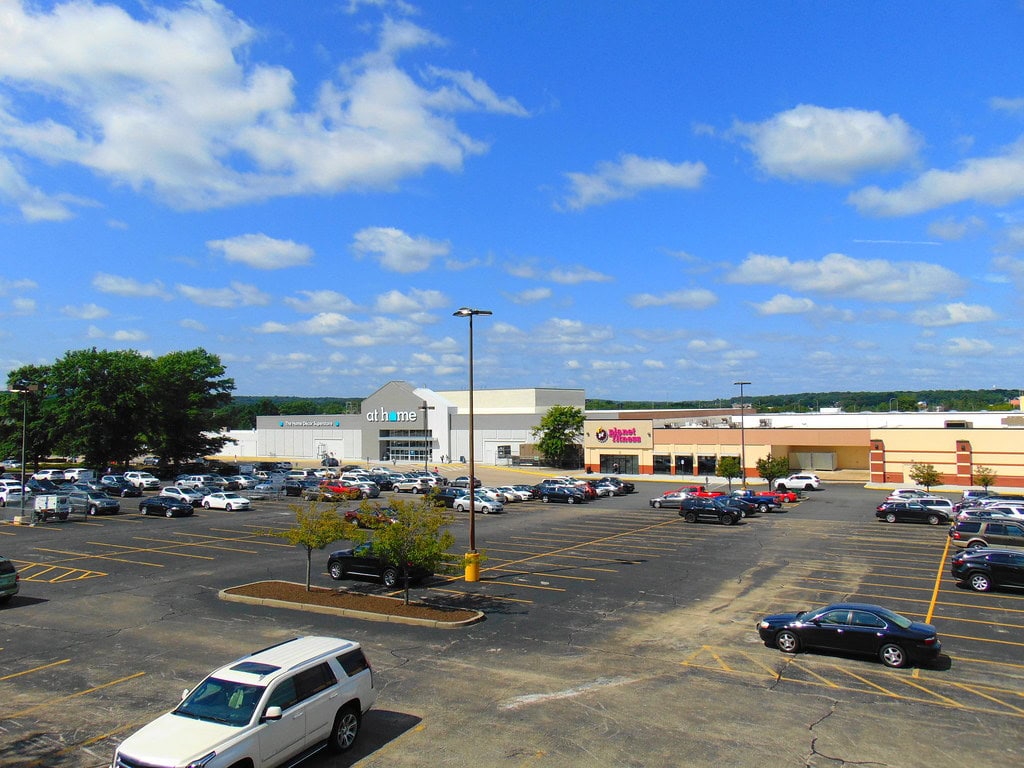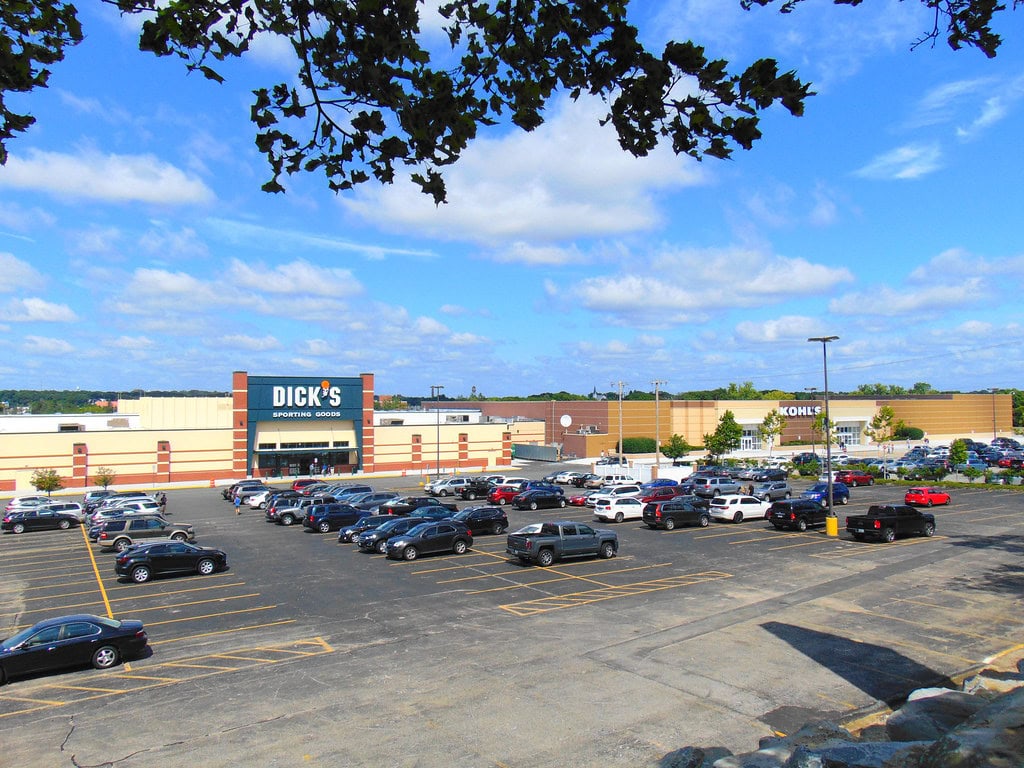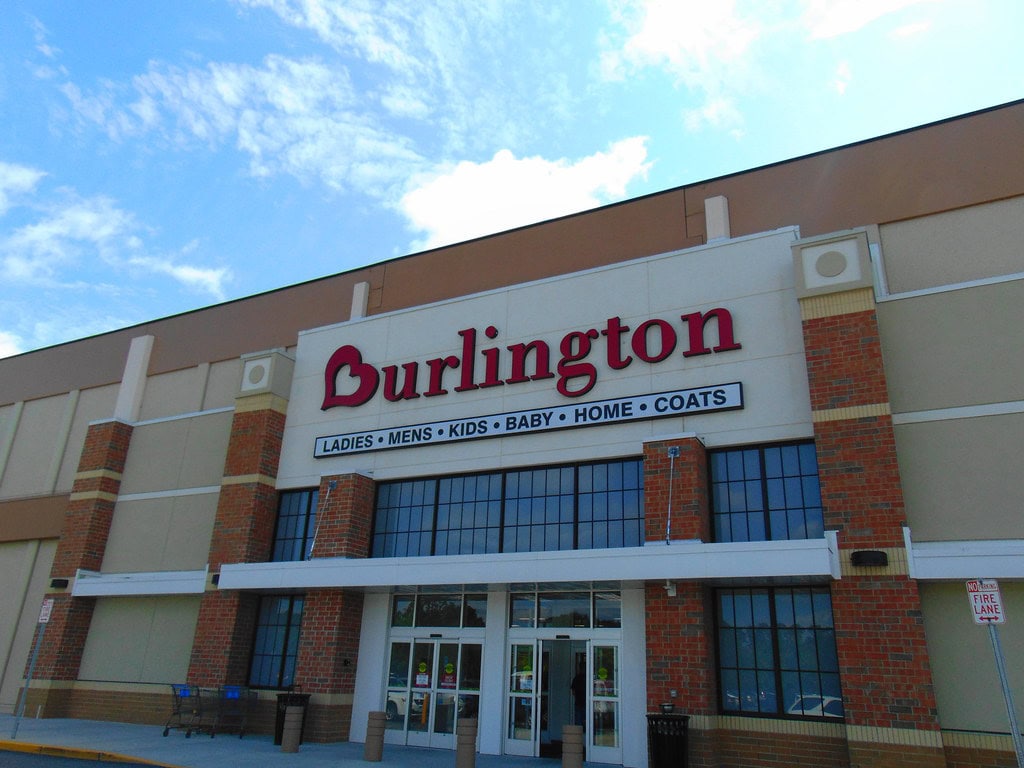Rhode Island Mall began as the Midland Mall in 1967, a fully enclosed, two-level retail space developed by Homart, a subsidiary of Sears.
It was one of the first malls of its kind in New England and was built during a period when suburban retail development meant more than parking lots and plate glass.
By 1970, Warwick Mall had opened nearby. Competition followed, but for a time, the Midland Mall shaped how shopping looked, felt, and functioned in this corner of Rhode Island.
Over the decades, it would be renamed, resold, downsized, and finally reimagined. The mall did not disappear all at once.
It was carved apart slowly by store closures, partial demolitions, and, ultimately, a pivot to big-box retail.
Site Work and Commercial Groundbreaking (1963-1967)
Homart Development Company, owned by Sears, acquired the site in 1963. At the time, the land was used as pasture. To prepare it for construction, crews flattened a hill and altered the course of the Pawtuxet River.
These early earthworks were substantial and marked a clear shift in how land was being reshaped for retail development.
The structure that opened on October 2, 1967, was a two-level enclosed shopping mall, an unusual configuration in Rhode Island at the time.
The original anchor stores were Sears, occupying 217,000 square feet, and Shepards, at 96,800 square feet. Together, they booked a space that contained 60 inline tenants on both floors.
Instead of escalators, the interior originally featured a Speedwalk brand ramp between levels. This element would later be removed during a renovation in the 1980s.
The layout focused on an interior corridor model, where customer movement was directed through a central space rather than external entrances.
No public records suggest major design revisions during this initial phase, which ran uninterrupted until the early 1980s.
Ownership Swaps and Tenant Shifts (1970-1985)
Competition changed the dynamic early. When Warwick Mall opened in 1970, just across I-295 from the Midland Mall, both malls operated simultaneously.
Warwick Mall had a newer layout and leaned heavier on entertainment branding. Midland Mall kept its format but soon faced tenant pressure.
Shepards closed in 1973. The anchor space didn't stay empty long. On October 4, 1977, G. Fox took over the former Shepards box, continuing the site's pattern of department-store leasing.
That deal extended through the first half of the 1980s until the retail holding company restructured the brand. Meanwhile, foot traffic held steady but never grew much past its opening decade.
In February 1981, Homart sold the mall to MetLife. That change led to a $4 million renovation in 1984. The upgrades added escalators and a glass elevator.
Around the same time, Sears remodeled its interior. Marketing and signage followed. On March 17, 1985, the name officially changed from Midland Mall to Rhode Island Mall.
No change to the property lines or footprint came with the rebrand. But tenants began to rotate faster, and the food court, labeled Greenhouse Cafes, emerged as a central amenity rather than an afterthought.

Anchor Consolidation and Structural Revision (1985-2000)
Retail turnover accelerated in the late 1980s. May Department Stores acquired G. Fox and its real estate in 1988.
By early 1993, the G. Fox name was retired, and its Rhode Island Mall location was converted to Filene's. That switch lasted only four years.
In 1997, Filene's shuttered its store at the mall and consolidated operations into Warwick Mall, which already had a larger footprint.
After Filene's closed, mall ownership moved quickly. In 2000, demolition began on that portion of the building.
The former G. Fox wing, along with the adjacent food court, was cleared and replaced with a two-level structure housing Kohl's on the upper floor and Walmart below.
Neither store opened into the interior mall. Their entrances faced the parking lot, and internal access was never added.
These changes affected the whole leasing model. While the new anchors were active and drew traffic, the rest of the mall didn't benefit from shared foot flow.
Inline stores began closing at a steady pace. The internal layout stayed intact, but its function changed.
Retail Attrition and Interior Decline (2000-2011)
By the early 2000s, the leasing strategy inside Rhode Island Mall shifted again, this time toward containment. Vacancy rates climbed year over year.
Instead of new retail, the spaces began filling with placeholder tenants, seasonal kiosks, temporary leasebacks, and non-retail offices.
The mall's one stable attraction was a DMV Express branch. It moved in as a cost-saving measure for the state and provided a steady trickle of visitors.
But even that wasn't permanent. On August 7, 2010, the DMV shut the location down. By 2011, only a handful of stores still operated from inside the original layout.
Royal Ahold, the parent company of Stop & Shop, leased several of the empty storefronts inside the mall. The move wasn't about filling space. It was meant to block Walmart from expanding into a full grocery format on the property.
Sears began closing off its internal access early that same year. Gates stayed down even during operating hours. In March 2011, they sealed the entrance with a partition wall. The mall closed its interior to the public on April 30.

Asset Sale and Redevelopment Planning (2012-2016)
On November 14, 2012, Winstanley Enterprises and Surrey Equities acquired the full mall property for $38 million.
The deal included both anchor parcels and all common space, giving the buyers full control over repositioning. The first idea floated was an outlet-style redevelopment, announced publicly in 2014.
Plans were called to maintain Walmart, Kohl's, and Sears while replacing the enclosed mall with open-air access and new leasing options.
By early 2016, the outlet model had been dropped. Construction pivoted toward big-box tenancy. Demolition work cleared interior corridors, and walls went up around four subdivided pads.
Burlington was the first confirmed lease. The new format eliminated any interior access and assigned dedicated parking and signage for each anchor.
During this phase, Dick's Sporting Goods and Planet Fitness were announced as incoming tenants, relocating from nearby sites.
Their planned square footage matched what was available on the subdivided platform. Exterior build-outs moved quickly.
Construction was slated to wrap in late 2016, with tenant fit-outs rolling into the following year. All retail storefronts were now independent entries.

Anchor Replacements and Parcel Redeployment (2017-2019)
Sears was the last original tenant, but its closure came in September 2017. That same year, Raymour & Flanigan announced plans to relocate to the first floor of the former Sears box.
At Home took the second level, moving from a nearby site after a zoning dispute involving Home Depot.
The outparcels followed a different rhythm. Hook & Reel and BJ's Brewhouse moved into parts of the old Sears Auto Center, which had gone dark two years earlier.
BJ's opened its first Rhode Island location there, using a shell left behind by garage service bays. These builds went quickly because they avoided the core footprint.
The retail square footage remained large, but by 2019, no tenant relied on shared space or cross-access. Each lease had its own signage, parking lot, and building entrance.
The mall interior no longer existed in any functional sense. Leasing was handled parcel by parcel, often listed under different broker names.
Midland Commons appeared on listings by the end of that year.

Tenant Rotation and Power Center Continuity (2020-2025)
By early 2020, the last phase of redevelopment centered on reconfiguring remaining outparcels. The Toys "R" Us space had been vacant since 2018 but reopened in May 2022 as BJ's Market.
This location differed from the chain's standard warehouse model, operating as a grocery-format concept with curbside infrastructure already in place.
Changes to the former Sears Auto Center were more layered. That building was subdivided and now hosts three tenants: BJ's Restaurant & Brewhouse, Hook & Reel Cajun Seafood & Bar, and SKECHERS Warehouse Outlet.
All three use separate entries, signage, and fit-outs.
On the Border, once listed among the food anchors, closed in spring 2025 following a corporate Chapter 11 filing. Chuck E. Cheese's and Wendy's continue to operate from the same pads they've used since the 1990s.
The property is now called Midland Commons. That name appears on commercial listings, retail directories, and tenant signage. The former name, Rhode Island Mall, no longer appears.

🍀




Well written with great details.
Thank you. The more details, the more chance someone else sees their own version of the place inside it.